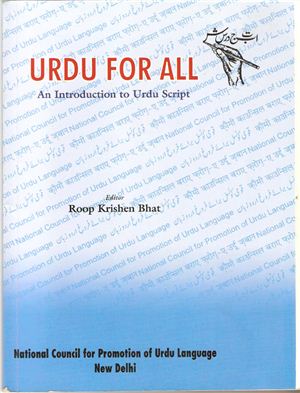Издательство :Narain & Sons
Год: 2005
Количество страниц: 114
This text is intended primarily for use in distance-leaing of Urdu courses focusing on teaching of reading and writing of the Urdu script. Each of the twenty lessons offered here is complemented by a corresponding lesson in the accompanying collection of Response Sheets. Together, the Response Sheets and this manual wiil provide the leaerwith a comprehensive knowledge of the basic rules goveing the Urdu script.
Organization of Lessons:
The explicit aim of this book is to introduce the Urdu Script to a beginner and alleviate many of the difficulties faced by the novice leaer, to whom the Urdu script may seem rather complicated. Structured in a way that deviates from traditional methods of Urdu pedagogy, this text presents the script in a simplified manner determined by linguistic principles and not by the alphabetical order that usually dictates the sequence in which Urdu letters are introduced.
In the 20 lessons here covering the entire Urdu alphabet, a Roman script transcription of Urdu sounds has been used in order to facilitate correct pronunciation. Leaers should pay particular attention to Roman transcription that illustrates the correct pronunciation of Urdu sounds. Though certain lessons in this manual include notes about the writing of the script, the Response Sheets supplementing this manual offer a more thorough introduction to writing in Urdu. Students should devote time to studying the step-by-step hand movements in the Response Sheets that show howthe script is handwritten.
The symbols of izafatin Urdu are not normally included in the primers of Urdu, however, being an integral part of Urdu writing system we consider it necessary to include it here.
Год: 2005
Количество страниц: 114
This text is intended primarily for use in distance-leaing of Urdu courses focusing on teaching of reading and writing of the Urdu script. Each of the twenty lessons offered here is complemented by a corresponding lesson in the accompanying collection of Response Sheets. Together, the Response Sheets and this manual wiil provide the leaerwith a comprehensive knowledge of the basic rules goveing the Urdu script.
Organization of Lessons:
The explicit aim of this book is to introduce the Urdu Script to a beginner and alleviate many of the difficulties faced by the novice leaer, to whom the Urdu script may seem rather complicated. Structured in a way that deviates from traditional methods of Urdu pedagogy, this text presents the script in a simplified manner determined by linguistic principles and not by the alphabetical order that usually dictates the sequence in which Urdu letters are introduced.
In the 20 lessons here covering the entire Urdu alphabet, a Roman script transcription of Urdu sounds has been used in order to facilitate correct pronunciation. Leaers should pay particular attention to Roman transcription that illustrates the correct pronunciation of Urdu sounds. Though certain lessons in this manual include notes about the writing of the script, the Response Sheets supplementing this manual offer a more thorough introduction to writing in Urdu. Students should devote time to studying the step-by-step hand movements in the Response Sheets that show howthe script is handwritten.
The symbols of izafatin Urdu are not normally included in the primers of Urdu, however, being an integral part of Urdu writing system we consider it necessary to include it here.

